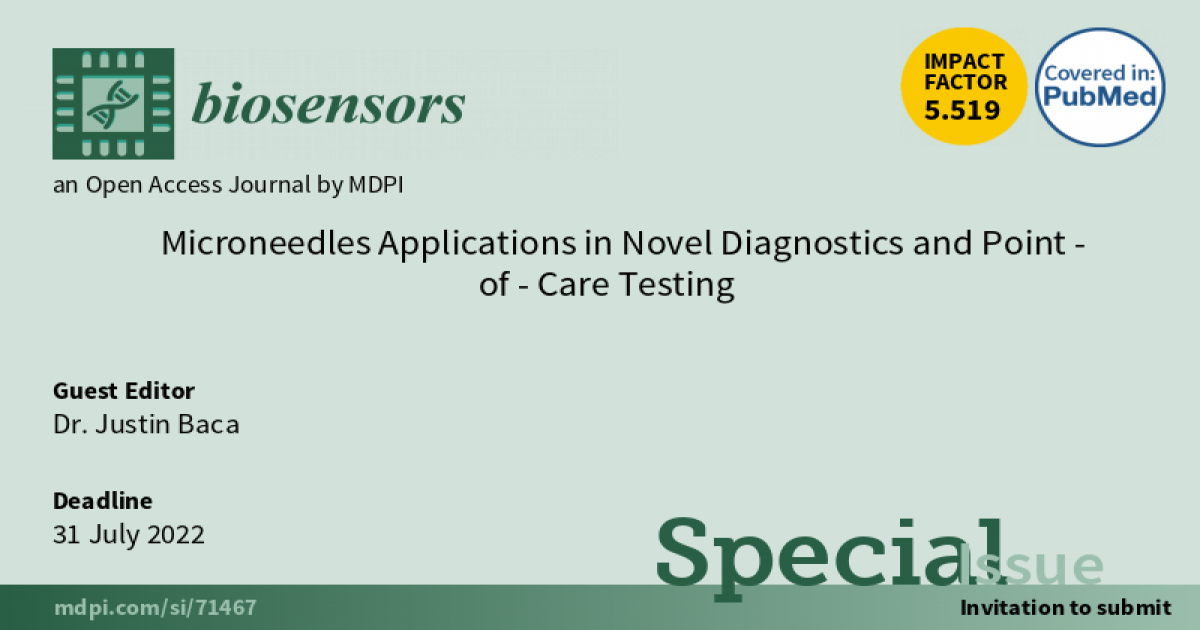Microneedles Applications in Novel Diagnostics, Wearable Sensors, and Point-of-Care Testing
A special issue of Biosensors (ISSN 2079-6374). This special issue belongs to the section "Biosensors and Healthcare".
Deadline for manuscript submissions: closed (31 July 2022) | Viewed by 643

Special Issue Editor
Special Issue Information
Dear Colleagues,
Recent advances in microneedle fabrication and integration have enabled new, minimally invasive sensing approaches. In addition to providing new insights into the composition of interstitial fluid, microneedle approaches may enable wearable and point-of-care sensors. This special issue focuses on advances in microneedle-enabled diagnostics from basic design and fabrication through initial clinical testing.
This Special Issue will include original research articles and reviews from academia and industry on microneedle applications in diagnostics and point-of-care testing. Particular areas of interest include the following:
- Microneedle integration with sensing technologies
- Novel microneedle manufacturing approaches
- Microneedle-enabled device design
- Microneedle-enabled wearable sensors
- Proof-of-concept studies
- First-in-human studies
- Human factors and usability studies
- Clinical studies of microneedle applications
- Localized skin reactions after microneedle application
- Interstitial fluid analysis
- Interstitial fluid storage
- Integration with wearable devices
- Integration with clinical information systems
Dr. Justin Baca
Guest Editor
Manuscript Submission Information
Manuscripts should be submitted online at www.mdpi.com by registering and logging in to this website. Once you are registered, click here to go to the submission form. Manuscripts can be submitted until the deadline. All submissions that pass pre-check are peer-reviewed. Accepted papers will be published continuously in the journal (as soon as accepted) and will be listed together on the special issue website. Research articles, review articles as well as short communications are invited. For planned papers, a title and short abstract (about 100 words) can be sent to the Editorial Office for announcement on this website.
Submitted manuscripts should not have been published previously, nor be under consideration for publication elsewhere (except conference proceedings papers). All manuscripts are thoroughly refereed through a single-blind peer-review process. A guide for authors and other relevant information for submission of manuscripts is available on the Instructions for Authors page. Biosensors is an international peer-reviewed open access monthly journal published by MDPI.
Please visit the Instructions for Authors page before submitting a manuscript. The Article Processing Charge (APC) for publication in this open access journal is 2200 CHF (Swiss Francs). Submitted papers should be well formatted and use good English. Authors may use MDPI's English editing service prior to publication or during author revisions.
Benefits of Publishing in a Special Issue
- Ease of navigation: Grouping papers by topic helps scholars navigate broad scope journals more efficiently.
- Greater discoverability: Special Issues support the reach and impact of scientific research. Articles in Special Issues are more discoverable and cited more frequently.
- Expansion of research network: Special Issues facilitate connections among authors, fostering scientific collaborations.
- External promotion: Articles in Special Issues are often promoted through the journal's social media, increasing their visibility.
- Reprint: MDPI Books provides the opportunity to republish successful Special Issues in book format, both online and in print.
Further information on MDPI's Special Issue policies can be found here.






